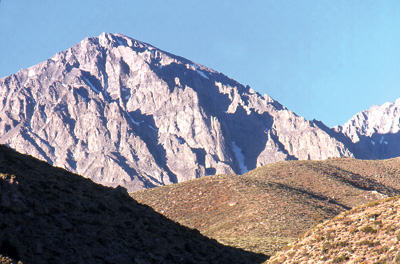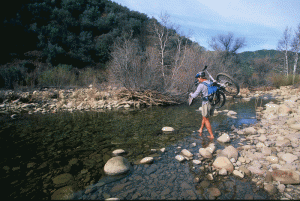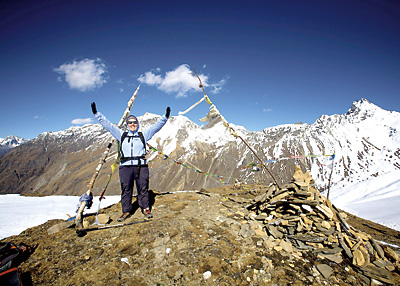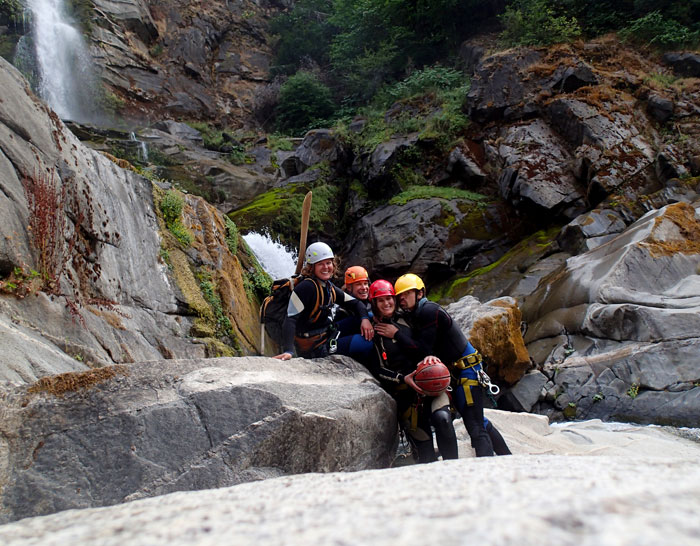- Tahoe’s Nevada Beach Tops the List of Hard-to-Book Campgrounds - 07/17/2024
- Cannabis Watershed Protection Program Cleans Up Illegal Grow Sites - 07/10/2024
- French Fire - 07/05/2024
Pondering the nature of alpinism in the High, and mild, Sierra
By Doug Robinson
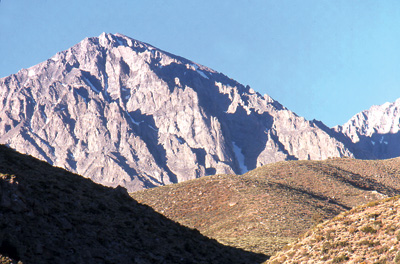
Hidden in plain sight: the untouched north face of Birch Mountain, seen as you drive up to the Palisades. Still, it took several years to notice, then decades to go climb it.
Photo Doug Robinson
“What is alpinism, anyway?” Terry Kearney was starting to rave as we burned through the last of our fuel. It was the morning after our second bivy. The sun played coy with our perch on the north face of Birch Mountain, in the outer orbit of the Palisades. “Is it all speed-aided 72-hour push up some heinous M8 wall? Is it just Steve House and the latest mad Hungarian? I love reading about that stuff, but I’ll never touch it. Maybe it’s more like two old men sharing one Ramen and no coffee for breakfast.”
Laughter broke out. High on this California version of alpine, we were starting our third day on an untouched north face in the Sierra, which after all is a semi-desert mountain range. Climbing in early May so the face would be sure to have snow on it, we hadn’t done a move over 5.6. Above us lay a bewilderment of ridgelines, not to mention lurking pockets of stacked terror blocks.
We’ve long since abandoned the direct. (Although, we keep telling ourselves, we can always come back for that.) We have no pretense of the cutting edge here. Like Terry, I’m in awe of the alpine feats of Dean Potter and Timmy O’Neill in far off Patagonia, and of everyone who has set a front point to Changabang (a steep, rocky 22,520-foot peak in the Indian Himalaya). But here we are instead, pacing through sagebrush approaches in running shoes like errant surfers. Everyone knows California sports some stout rock climbing. But our alpine zone, like our weather, is often a bit gentler. This is more like what my Palisades mentor Smoke Blanchard called “mild mountaineering.” We could care less; we’d much rather revel in our good fortune to be nowhere else but right here. No envy, no regrets, just pile on the fun-hogging. To us, alpinism means less. And more.
Anyway, powered by six noodles we sidled west over a black ridge, down two raps, and chopped a full pitch of steps across a crescent of couloir. Not exactly the direct line.
“Holy fuck! Rock!” I snapped the belay tight. A loose block had rolled onto Terry’s ankle, searing his shin. A moment of blind panic, then another moment of regaining composure. It’s OK … this time.
The wariness is constant. Bands of looseness have cropped up ever since we stepped off the snowfield approach onto blocky fourth class. That was two days ago now, and in spite of long stretches of stellar solidness and dreamy incut holds – like snaking right up the center of the first buttress easy as you please – the teetering and hanging stuff keep punctuating. If the architecture of this north face is reminiscent of Temple Crag – which is only 8 miles away – then the wariness of stacked blocks and loose flakes is familiar too. As Robinson Jeffers put it, “History falls on your head – like rocks.”
Terry remembers. Two years before, we were climbing on Temple Crag itself when a head-sized block clipped his shoulder. We patched him up and went on. His wife, Mauri, was more freaked than Terry – she had dislodged it at a touch. Mauri and I watched in terror, the long moments lengthening, as the block ricocheted. Terry poised like a cat, waiting out its sudden, random re-direction. It lurched again; Terry made his split-second move. The block whizzed through the spot his head had just left. His helmet wouldn’t have helped much.
That day on Temple Crag, we went on, engaging the upper pitches of the Moon Goddess Arete. I had never done the second half of that climb – not in 35 years of guiding on the crag. See, there’s a bail-out spot half way, left into a gully. Mighty handy for slower parties, and it’s true that I’m not known for putting much alpine into my alpine starts. So it was an adventure that afternoon to unfold the traverse to the right and the steep crux above. I raced up it, climbing fluidly and pushed by darkness, thinking that the upper pitches actually felt less loose. Since then, that high crux pitch has claimed two lives.
So I’m going to come right out and say what’s been building inside me for years now: the Moon Goddess is no longer a rock climb. It’s just gotten too loose. Stay off. Do the Venusian Blind instead. I’ve hesitated mightily to say this because it seems crazy that a climb has gotten looser. Much more likely, I figured, that I was just getting old and conservative. Logical for the change to be in me – creeping old-fart-ism.
But then I ran into an odd story that sparked me to propose the theory of the Atomic Broom (for the full story see the sidebar, “The Atomic Broom Theory” at the end of this article ).
The gist: During the height of the Cold War 1950s, there were hundreds of atomic bomb tests at the Nevada Test Site (a total of 1,021 “announced” nuclear blasts between 1951 and 1992, of which 921 were underground.) The test site is 65 miles northwest of Las Vegas, roughly 100 air miles east of the Sierra Crest. These blasts sent shock waves unobstructed into the high peaks that, over time, shook much of the loose rock from its tenuous moorings.
When the golden age of Sierra climbing got underway in the ‘60s and ‘70s, little did we know that our mountain stage had been swept of its customary level of loose rock. In the decades since, that loose rock has begun to return to its pre-Cold War levels, and some of the climbs that were established during that golden age have now become exceedingly more shaky and dangerous.
*******************
So alpine is loose. What else? Snow? Ice? Sure.
A pitch of step-cutting up perfect neve has gained us access to this promising exit ridge, way up the north face of Birch Mountain. Carrying a light axe is the key to this highway, the perfect complement to mountaineering in approach shoes. If you work the timing. We came early in May for the relief of snow blanketing a grinding scree slope at the foot of the ridge. Way more fun to kick steps. Not to mention a handy snowpatch to melt for water last night at the bivy. Another the night before. This early in the season, though, actual ice won’t happen until later.
Even in this seemingly-desert range it does get icy. Back in our days as basking Armadillos, barefoot and indolent at our sandy Palisades camps during that golden age – now receding into a glaze of forgetfulness – ice axes drip-dried against a boulder. Couldn’t even approach any of the peaks without them. We might wait patiently until October to sharpen them up and add crampons, but by then the untouched ice gullies above had taken on a flinty gleam. And our ability to climb them was freshly enhanced. Curved axes! Rigid crampons! Yvon Chouinard – the original surf rat gone alpine – delivered a set to me at 12,500 feet on the edge of the Palisade Glacier. They were hot off of his forge in Ventura that October of 1969. And the next day, clawing our way up the brittle V-Notch, his ice climbing revolution became undeniable. Vertical could wait a few years; that day, just the ability to cling to ice so dense you could peer into its crystalline depths was astonishing.
Alpine is the jagged edges of our planet that poke up so high they run into airplanes. Peaks that tear at the jet stream and call down weather. Ice in the desert indeed. At least a little while longer. The Palisade Glacier, shrinking at an alarming rate, seems 40% less than its bulk in the ‘60s. The bergschrund on North Pal yawns wider now as its glacier pulls away. Many are the parties these days who scratch their heads at the gaping ‘schrund, its upper wall overhanging like a breaking wave. They’re forced to wonder: this is fourth class? Not any longer. Half the summer now the only way around it is a solid pitch of 5.7 granite. As our global summer lengthens, this classic’s reputation as a moderate climb recedes. Love it while it lasts.
Alpinism is what we commit up here, with our heads bumping into the jet lanes.
*******************
Climbing alpine can mean a V1 boulder problem in the midst of fourth class. Had one of those today on our first try at an exit ridge, the one that turned us away. We tossed the rope up over the edge of the ridge above to protect the tricky friction face. Nice minimalist technology. Leaving no trace. But also no exit. Couldn’t get up it, so reluctantly we sacrificed a wired stopper, the only tiny trace we will leave on this entire mountainside, to lower and regroup.
I had another bouldery moment later in the summer on the striking North Ridge of Lone Pine Peak. It’s a climb that keeps drawing me back too. So it was maybe my fifth or sixth trip up there (alpinism, for me, is also losing count) – and 80 feet out I was abruptly stemming for life up an open book gone vertical. Legs splayed, approach shoes smearing. No pro in, naturally, and the rope billowing out below me, but I was more concerned with cumulus and distant thunder. Another climb that’s just a 5.6. I won’t challenge the rating, but it’s huge and one does wander. So out on a buttressy interruption of “it’s a ridge, stupid” route finding, and committed to a corner I’ve never seen before and likely couldn’t find again, my next move is .10- and I’ll get seriously pummeled if this reachy smear breaks traction.
Alpine is airy. And some of those Sierra ridges are sharp enough to cut you. I’ve seen them cut ropes. Purple nylon fused to the acute edge of a block. Broken body inert on the rocks below.
We try the next ridge over. Like climbing into the upper limbs of a birch, more possible ways branch out. This one has low relief, standing out only 70 feet from the bedrock of the north face. Maybe this will be the passage that breaks us out of the maze. It has the right feel of fine big blocks mortised together by the underlying grain of the granite, and mercifully solid. And it’s holding exactly to the modest grade. We scurry upward with summit fever.
*******************
Alpinism can be generous, although this climb has been a piss-poor example, and I feel tainted by the whole competitive secrecy thing that built up around it. I got into a pissing match with Mike Strassman over it. Friends and work-mates, with a shared creative history – we made the original Moving Over Stone video together, which verged on art — and suddenly we’re sneaking around scheming on copping the first ascent. Hoping to name it after my dead friend not yours. Surfers are far worse, though, hoarding secret breaks and sneering kooks right out of the lineup. “Valleys go home!” But cavers get the paranoia award. I’ve heard of iron bars locked across ‘their’ territory. What if you found another entrance and were tunneling for daylight when you came up hard against the other side of somebody’s bars, hard up against their crude attempt to hoard a corner of the cosmos? I think Smoke Blanchard got it closer to right after trailing an early Buttermilk bouldering session: “the gentlest form of competition I’ve ever seen.” That impulse to compete will always be there. However, day by day we can choose how much we engage with it.
Hoarding is silly anyway, in the face of the thousands of untouched walls littering the Sierra backcountry. Consider the scene a few months later, at the other end of this alpine season. I found myself in a valley directly west of Mt. Whitney. Alpine Lake is the only named feature. Glancing up, I mistake an airy, sculpted ridge for Mt. Russell’s famously graceful Fishhook Arete. But no, it’s a nothing on an unnamed peak. A couple of miles west of the Fishhook.
It was interesting to cross Whitney-Russell Col and see all footprints turn toward Russell, with only two sets this year going west into this alpine variety pack. Six hundred foot walls of vertical white granite rise right behind our camp on the south face of Mt. Hale. And a mile away looms the north face of Mt. Hitchcock, with 800 to 1200 foot ridges and walls sculpted out of the same dark granite as Temple Crag and Middle Cathedral Rock. I had to check Secor’s guidebook to believe it, but on the whole mile-wide sweep of that wall there is one trivial fourth class line up a gully.
So go for it. Gleaming unclimbed walls are everywhere. I want to climb them all myself, but bigger than that is the urge to share. Don’t forget, though, that they are guarded by sweat. The quickest approach over Whitney-Russell Col climbs 5000+ feet. Very alpine – at least in the hot, sandy-canyon way of the Sierra. We pay in our own fashion for all this fine weather. Anyway, that approach is a great workout, probably builds character, and is drop-dead beautiful. No doubt it confers hardman points. Taking it on is meditative too.
By the time we hiked out the Whitney Trail we’d had a 10,000-foot jaunt. Ten up, ten down. No summit, either, though we did get nine pitches up a cool line on the untouched West Face of Whitney, before bailing in twilight and scrambling half the night back to camp. The climbing had edged into 5.9 on white granite cleaved into large blocks, standing up into the sky. On our next try, two years later, Michael Thomas and I pushed through to the summit, though it took us fully 20 pitches and we couldn’t unrope, exhausted, until 2:30 in the morning. We’ll be back there too, I hope; half a dozen more ridges lie alongside, all untouched. Maybe next time we’ll run into you out there too?
Competition: it’s not a bad thing. It sharpens us, keeps the juices flowing. It makes us reach harder and raises the whole standard of climbing. In the long run we’ve come by it honestly enough; competition is our evolutionary heritage. But so is co-operation. Family, language, a community of effort. We’re not always good at those things, the newer and more fragile tools in our kit, but they’re fully as crucial to who we are and where we’re going together. Tie on in.
So alpinism is also an old friend showing up out of the blue at 10,000 feet. I was loaded down with freight, excess baggage lashed all over my pack, staggering wearily toward the road; Rick McUsic offered an empty pack and inspired conversation on the downward reach.
Competition and cooperation. They are another of those big dualities we get to chew on. Like pride and humility. Like fear and desire. Climbing sets them a stage, and alpine air encourages the rumination. How you play them out affects everything, from getting laid to the future of humanity. Even to whether it has a future. Will us humans make it out of here alive?
Climbers have chosen an active life. And at this digital stage of human culture, simply getting active can seem like a throwback. A bit crude, like rustling up a coonskin cap and playing mountain men. We can be our own best caricature. Patronizing snickers arises from overstuffed rooms. A frontier fetish, perhaps? But ever since that literal frontier recoiled from the shore of the Pacific and washed back on itself, the higher ranges inland and the great sweeps of desert between them have been as good a Wild West as I’ve found. And staring down off this virgin north face of Birch Mountain hidden for generations in plain sight, we’re breathing the thin, sharp air of the frontier. Sure Pakistan would be cool, but the High Sierra is right at hand and we’re pretty committed up here for a couple of guys just three days off our keyboards. Out of fuel and getting thirsty and pushing beyond the 13,000-foot parallel. Turn back to the rough granite, then, commit to this new ridge. Push upward into the unknown.
Alpinism is an answer to the question of why the reckless survive. A pretty rhetorical question it is to us, though, lacing snug our boots and pulling down toward the ultraviolet beyond. And sure enough that twisted desert poet Arthur Rimbaud got it right that “women love those fierce invalids, home from hot climates” which offers the promise of a sweet, sweaty immediacy to what is otherwise an evolutionary abstraction.
I’m teased by that moment of clarity, just as I reach to mantle another block on the ridge. Then another bolt strikes out of this blue. Laughter wells. A self-aware flash, realizing just this: that realization happens. Deceptively simple. And it brings me – well, not “to my knees,” because of course I’m in the middle of a move, but it does make me pause. It changes everything.
Alpinism sharpens my thoughts, my mental acuity. Insight: what part does it play in the arc of your being? Ever get derailed by a penetrating observation? Sure, and up here it seems to happen more often. It’s like I think more fiercely. Useful for an old guy, still half wild, cruising – or is it striving? – in the alpine zone. More dualities. Poles to pull us apart, poles to knit our selves together. At least up here I’m forcibly reminded to contemplate these things as much with my feet as with my overstuffed brain. Stay nimble. It’s useful for dodging the patches of rickety rock on this ever-loosening, ever-loving alpine terrain. And it’s just as crucial for sidestepping the choss of history. That too seems to be growing ever looser around us. Nimble is another way to be humble. Getting too puffed up with yourself just makes it harder to wisp through the next keyhole of insight.
Alpinism gets tired. The climbing became stellar again once we branched onto our true exit ridge, but after six more pitches we were happy to unrope. We kicked around the summit for a while. Browsed through the register, full of the enthusiasm of skiers ripping skins for an epic descent of the south slopes. We added a note commemorating our effort to the great Bardini, now that he has transcended all rockfall. Then we got distracted by unclimbed walls and ridges littering the skyline. Even caught ourselves getting enthused. Lifting, momentarily, out of the serene glow of completion into the enticement of virgin rock deeper into the backcountry.
Finally, we jumped onto the snow and glissaded fully 5000 feet, dreaming of burgers as we shuffled out through sage and meadows of blooming iris. It was the easiest alpine descent either of us could remember.
Doug Robinson, a Sierra guide for more than 40 years, is author of “A Night On the Ground, A Day in the Open.” When not musing in the mountains, he bivies in Santa Cruz County.
The Atomic Broom Theory
Was the High Sierra preternaturally cleaned of loose rock by weapons testing in Nevada? The evidence keeps tumbling down, says veteran climber Doug Robinson
By Doug Robinson
After some four decades of guiding the Palisades, widely regarded as the most impressive alpine region of the High Sierra, the crash of rockfall began scaring me off certain climbs, such as the classic Moon Goddess on Temple Crag. At first, I figured the change was within me, a creeping old-fart-ism, not an actual change in the rock.
But then I ran into an odd story that sparked me to propose the theory of the Atomic Broom. Daniel Wenger is another graying climber, who took up this ascending passion after 60. We often swap belays at Pacific Edge, our local gym in Santa Cruz. One day Daniel told me about backpacking into the Palisades in 1952. He was awakened before dawn by a sickly yellow flash in the eastern sky, followed by a huge rocking blast, and then rockfall from every peak in the cirque.
Decades of living in the Palisades all summer have gotten me used to bomb blasts. The deep rumble of target practice rolls in from the Nevada Test Site, slightly over a hundred air miles away. Those bombs, even conventional weapons, would pulse our eardrums. But Daniel’s story sounded a whole lot bigger.
Then it hit me: Atomic Bomb. That’s right when a lot of them were blown off, an even hundred above ground, in the desert north of Las Vegas. The Cold War. H-bombs, even. Scores of atomic tests, and they went on for years. As a kid I saw the photos in Life magazine. The Army had even lined up troops a few miles away, to see if they’d be able to fight afterward. And then, decades later, when the radiation damage began showing up with cancer clusters downwind in Utah, the Army had conveniently “lost” their lists of which guys were in those tests.
But back to the rockfall they triggered. Booming down off every peak in the cirque.
We started showing up in the Palisades not that long afterward, in the early ‘60s. First Don Jensen, who made the first ascent of the Moon Goddess with clients in 1969, and then my crew from Yosemite. Unconsciously, we calibrated our sense of the relative solidness of the rock. But quite unknown to us the whole east-facing rampart of the highest Sierra had been scoured by the Atomic Broom.
Think about it. Those were the biggest explosions mankind – compulsively playing with fire – has ever ignited. Mega-tonnage of blast power rolled out massive shockwaves through the atmosphere. Those pulses cleared the Inyo Mountains and the Funeral Range above Death Valley and slammed into the eastern escarpment of the High Sierra. It’s a direct hit on the highest walls up under the crest, where the shock wave scoured the East Face of Whitney and the magnificent ribs and buttresses of Mt. Russell. They were about 100 miles from Ground Zero, with the Palisades barely a few miles further.
That’s where young Daniel awoke to the result: rockfall pouring off of every peak, rattling the Sierra dawn.
The atomic blasts went on for years, nearly a thousand of them in all, if you count the biggest explosions that were detonated underground. Often enough they too breached the surface. The highest Sierra was being relentlessly swept by the Atomic Broom.
We had waltzed into a landscape artificially swept clean of loose rock. Who knew?
Then, gradually over the five decades following, each year’s frost-wedging has teetered more blocks. Things are returning now to a normal we have never known. Normal for the peaks, but it feels loose to us.
It just happened that all those first ascents, our little golden age of technical walls and airy aretes in the High Sierra from the late ‘60s through the early ‘70s, were done in a period of unusual solidness, a historical anomaly. We were innocent beneficiaries of the Atomic Age.

